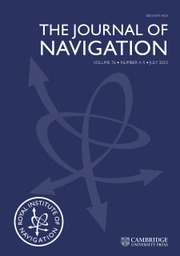Article contents
Practical Rhumb Line Calculations on the Spheroid
Published online by Cambridge University Press: 21 October 2009
Extract
About ten years ago this author wrote the software for a suite of navigation programmes which was resident in a small hand-held computer. In the course of this work it became apparent that the standard text books of navigation were perpetuating a flawed method of calculating rhumb lines on the Earth considered as an oblate spheroid. On further investigation it became apparent that these incorrect methods were being used in programming a number of calculator/computers and satellite navigation receivers. Although the discrepancies were not large, it was disquieting to compare the results of the same rhumb line calculations from a number of such devices and find variations of some miles when the output was given, and therefore purported to be accurate, to a tenth of a mile in distance and/or a tenth of a minute of arc in position. The problem has been highlighted in the past and the references at the end of this show that a number of methods have been proposed for the amelioration of this problem. This paper summarizes formulae that the author recommends should be used for accurate solutions. Most of these may be found in standard geodetic text books, such as, but also provided are new formulae and schemes of solution which are suitable for use with computers or tables. The latter also take into account situations when a near-indeterminate solution may arise. Some examples are provided in an appendix which demonstrate the methods. The data for these problems do not refer to actual terrestrial situations but have been selected for illustrative purposes only. Practising ships' navigators will find the methods described in detail in this paper to be directly applicable to their work and also they should find ready acceptance because they are similar to current practice. In none of the references cited at the end of this paper has the practical task of calculating, using either a computer or tabular techniques, been addressed.
Information
- Type
- Research Article
- Information
- Copyright
- Copyright © The Royal Institute of Navigation 1996
References
REFERENCES
- 17
- Cited by

